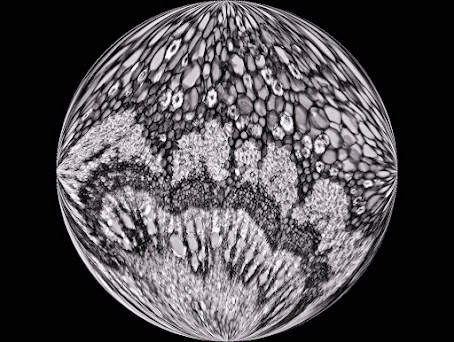Oms is a beautiful village, in the ancient region of Roselló (nowadays Eastern-Pyrenees, France), in the south of historic region of Occitània. This locality includes different mining sites of scientific interest. One of these mining operations is in the Correc d'en Llinassos (torrent), near Oms (mindat.org, loc-49065).
This deposit was studied by the AFM (Association Française de Microminéralogie) in the middle of the last decade (Berbain & Favreau, 2007). In this article, numerous species were citated, the most interesting containing minerals were the Ni: annabergite, bottinoite, gersdorffite, glaucospherite, millerite, ullmannite. It is necessary to add one more that was identified for the first time worldwide: omsite, named after this locality (type locality) (Mills et al., 2017). This is a very rare hydroxyantimonite of iron, nickel and copper, member of the cualstibite group. Correc d’en Llinassos is also the type locality for hydroxyferroroméite, identified in 2017 (Mills et al., 2017a).
During a visit to the mine, with prior authorization from the owner of the farm, since access is prohibited, it was possible to collect various mineral specimens from the outer area of the mine, to later be studied. Among them, some globular aggregates of white color on siderite stood out, which after being analyzed by SEM-EDS indicated that it could be some magnesium carbonate. The Raman spectra obtained were consistent with dypingite or hydromagnesite. To close the study, a powder X-ray diffraction was carried out. Both the spectrum and the cell yielded values confirmed that it was hydromagnesite. This mineral had not been described in this mine.
Globular white aggregates of hydromagnesite accompanied by Mg rich malachite
XRD spectrum (powder): hydromagnesite from Oms.
Courtesy: Geociències Barcelona, Geo3BCN–CSIC, Bruker D8-A25 (Cu Kα, PSD detector)
On the other hand, it was possible to observe several globular aggregates of green colour that could correspond a visu with malachite. Reaction with HCl indicated that it was a carbonate. A copper-nickel hydroxylcarbonate from the Rosasite group has been described in this deposit, which could be identified as glaucospherite, by appearance and chemical reaction. Raman spectra also indicated that it was a similar mineral malachite. The studies were carried out using SEM-EDS and the results were very interesting since, surprisingly, most of these malachite aggregates contain a certain percentage of magnesium (Mg: Cu 1: 4-6).
Green globular aggregates of magnesium rich malachite with aragonite (white)
SEM-EDS uncoated. Malachite Mg-rich
Cortesy: Geomar-Enginyeria del Terreny, SEM-EDS Phenom G5 XL
Its resemblance to the photographs published as glaucospherite from this deposit suggests that, in some cases, without chemical analysis it may be difficult to identify one or the other mineral. After reviewing numerous specimens, it was possible to find globular aggregates of a sky blue to bluish green color, in which magnesium and copper were found in 1: 1 proportion. It was, unsurprisingly, identified as McGinnessite.
Globular aggregates of blue-green mcguinnessite acompanied by Mg-rich malachite (green)
SEM-EDS uncoated. Mcguinnessite from Oms.
Cortesy: Geomar-Enginyeria del Terreny, SEM-EDS Phenom G5 XL
Mineral deposits, although studies have been published on them, do not cease to amaze. Continued study will enrich the country's mineralogical heritage and contribute a grain of sand to science. Obviously, also supporting the collaboration between academic mineralogists and amateur mineralogists, mineralogists after all, is our duty and obligation.
Acknowledgments
Thanks to Geomar-Enginyeria del Terreny for SEM-EDS studies; Dr. Jordi Ibáñez and Soledad Álvarez, Geociències Barcelona (GEO3BCN - CSIC); Dr. Tariq Jawhari, Raman departament of Centres Científics i Tecnològics de la Universitat de Barcelona (CCiTUB); Dr. Joan Carles Melgarejo (UB) to facilitate the study of the samples and to the owner of the property where the mine is located.
Bibliographical notes
- Berbain, C., Favreau, G. (2007): “Un exemple peu courant de minéralisation nickélifère: le Correc d'en Llinassos à Oms (Pyrénées-Orientales)”. Le Cahier des Micromonteurs, 95, 1, 3-24.
- Mills, S.J., Kampf, A.R., Housley, R.M., Favreau, G., Pasero, M., Biagioni, C., Merlino, S., Berbain, C., Orlandi, P. (2012): “Omsite, (Ni,Cu)2Fe3+(OH)6[Sb(OH)6], a new member of the cualstibite group from Oms, France”. Mineralogical Magazine, 76, 1347-1354.
- Mills, S.J., Christy, A.G., Rumsey, M.S., Spratt, J., Bittarello, E., Favreau, G., Ciriotti, M.E., Berbain, C. (2017a): “Hydroxyferroroméite, a new secondary weathering mineral from Oms, France”. European Journal of Mineralogy, 29, 307-314.
- Mindat.org: “Correc d'en Llinassos (Ravin d'en Llinassous), Oms, Céret, Pyrénées-Orientales, Occitanie, France”. https://www.mindat.org/loc-49065.html [on line 11/2021].














